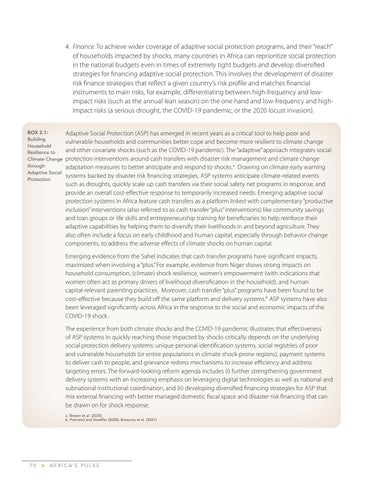4. Finance. To achieve wider coverage of adaptive social protection programs, and their “reach” of households impacted by shocks, many countries in Africa can reprioritize social protection in the national budgets even in times of extremely tight budgets and develop diversified strategies for financing adaptive social protection. This involves the development of disaster risk finance strategies that reflect a given country’s risk profile and matches financial instruments to main risks, for example, differentiating between high-frequency and lowimpact risks (such as the annual lean season) on the one hand and low-frequency and highimpact risks (a serious drought, the COVID-19 pandemic, or the 2020 locust invasion). BOX 2.1: Building Household Resilience to Climate Change through Adaptive Social Protection
Adaptive Social Protection (ASP) has emerged in recent years as a critical tool to help poor and vulnerable households and communities better cope and become more resilient to climate change and other covariate shocks (such as the COVID-19 pandemic). The “adaptive” approach integrates social protection interventions around cash transfers with disaster risk management and climate change adaptation measures to better anticipate and respond to shocks.a Drawing on climate early warning systems backed by disaster risk financing strategies, ASP systems anticipate climate-related events such as droughts, quickly scale up cash transfers via their social safety net programs in response, and provide an overall cost-effective response to temporarily increased needs. Emerging adaptive social protection systems in Africa feature cash transfers as a platform linked with complementary “productive inclusion” interventions (also referred to as cash transfer “plus” interventions) like community savings and loan groups or life skills and entrepreneurship training for beneficiaries to help reinforce their adaptive capabilities by helping them to diversify their livelihoods in and beyond agriculture. They also often include a focus on early childhood and human capital, especially through behavior change components, to address the adverse effects of climate shocks on human capital. Emerging evidence from the Sahel indicates that cash transfer programs have significant impacts, maximized when involving a “plus.” For example, evidence from Niger shows strong impacts on household consumption, (climate) shock resilience, women’s empowerment (with indications that women often act as primary drivers of livelihood diversification in the household), and human capital-relevant parenting practices. Moreover, cash transfer “plus” programs have been found to be cost-effective because they build off the same platform and delivery systems.b ASP systems have also been leveraged significantly across Africa in the response to the social and economic impacts of the COVID-19 shock. The experience from both climate shocks and the COVID-19 pandemic illustrates that effectiveness of ASP systems in quickly reaching those impacted by shocks critically depends on the underlying social protection delivery systems: unique personal identification systems, social registries of poor and vulnerable households (or entire populations in climate shock-prone regions), payment systems to deliver cash to people, and grievance redress mechanisms to increase efficiency and address targeting errors. The forward-looking reform agenda includes (i) further strengthening government delivery systems with an increasing emphasis on leveraging digital technologies as well as national and subnational institutional coordination, and (ii) developing diversified financing strategies for ASP that mix external financing with better managed domestic fiscal space and disaster risk financing that can be drawn on for shock response. a. Bowen et al. (2020). b. Premand and Stoeffler (2020); Bossuroy et al. (2021).
70
>
A F R I C A’ S P U L S E

